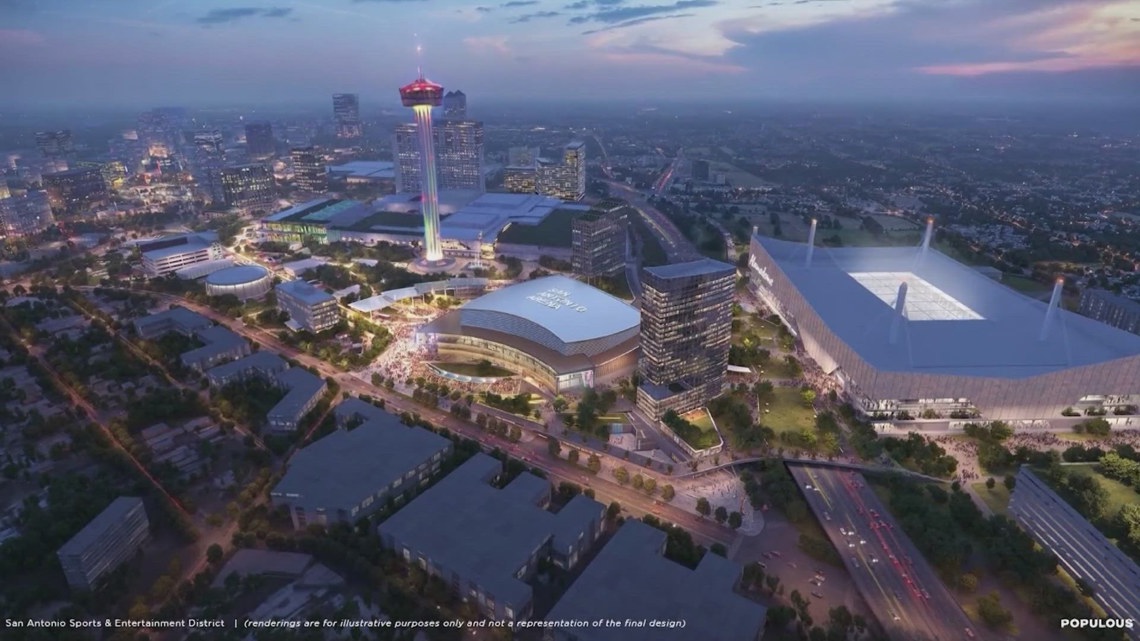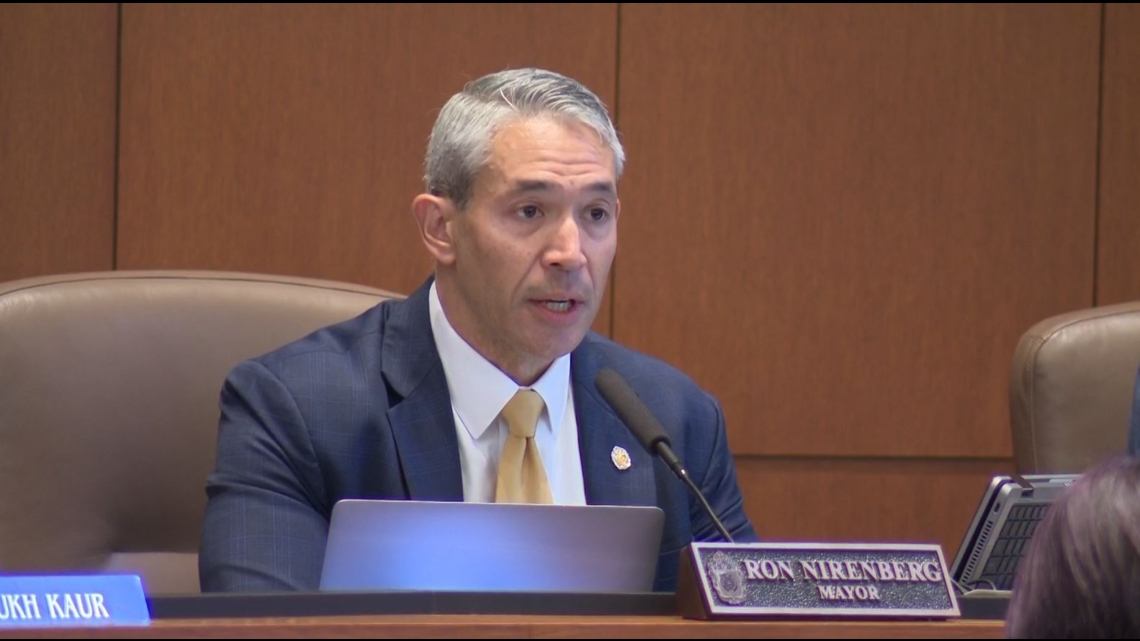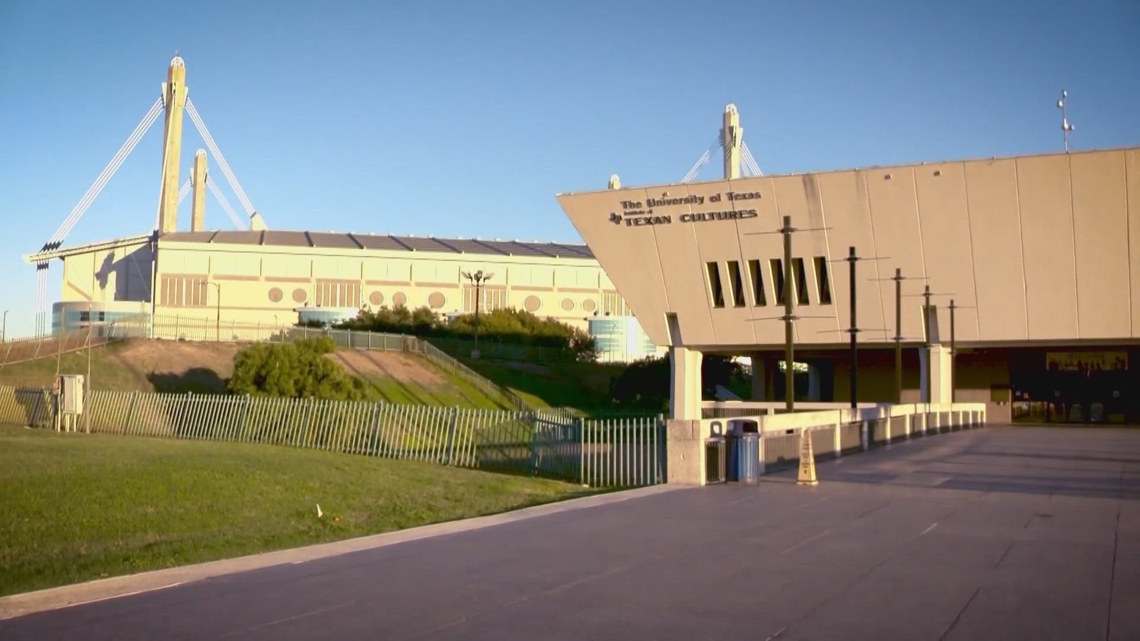The agreement includes deadline for when local leaders plan to publicly share funding plans for a new downtown arena.
SAN ANTONIO — On the same weekend that Final Four mania is hitting San Antonio, the future of the city’s beloved NBA team took its own huge step to the proverbial basket—a new arena in the heart of the city.
On Friday, officials with the City of San Antonio, Bexar County and the Spurs put pen to paper and signed off on a non-binding agreement to begin meaningful conversations about what it would take to build the team’s next home downtown. It marks an important step in the city’s dream for a sprawling sports and entertainment district anchored by a new arena, but which incorporates other major projects like expanding the Henry B. Gonzalez Convention Center; upgrading the Alamodome; building a walkable land bridge over Interstate 37; and laying the foundation for new retail and housing development in the area.
Those are the projects specifically outlined in the memorandum of understanding (MOU) signed by the three parties, five months after the so-called “Project Marvel” blueprint was publicly unveiled for the first time. But a new arena is the only one that includes Bexar County’s involvement.
“This is an exciting project that we believe presents the opportunity to energize our economy, strengthen our community and position San Antonio for long-term success,” Spurs CEO RC Buford said.
The finalized MOU also cements key deadlines added to the agreement in recent months.
The most imminent deadline? Right about now. A clause in the MOU related to “community outreach and benefits” stipulates that the county, the city and the Spurs will produce a plan “aimed at getting input from stakeholders and communities that may be affected by the Projects… by the beginning of April 2025, to the extent feasible.”


The city estimates a new Spurs arena will cost between $1.2 billion and $1.5 billion. As far as the most pressing question – how will it be funded? – those plans, or at least the “respective contributions for a funding framework” from the county, city and Spurs, are expected to be publicly revealed “no later than the beginning of July 2025, to the extent feasible.”
One of the key funding sources could end up being Bexar County venue tax, which the county has said could contribute as much as $400 million for the arena in its current state. But voters must first OK that allocation in November, and Bexar County Judge Peter Sakai has indicated officials only have until the start of August to get that question on the ballot.
The Spurs have conveyed to the city that they want to move downtown by 2032, which is when their lease at the Frost Bank Center. The arena would have between 18,000 and 20,000 seats, comparable with other NBA venues.
Mayor Ron Nirenberg said in a press release that the MOU “allows us to begin a thoughtful and transparent process, not only to explore what will be necessary to fund this project, but also to engage directly with our residents to better understand their needs and priorities.”
“San Antonio deserves world-class opportunities,” continued the mayor. “And our residents deserve to have a voice in shaping them.”
Crucially, the talks are kicking off in earnest as Nirenberg’s time in office winds down. He’ll leave the mayoral seat in June after serving four terms, the maximum allowed by the city charter.


What will happen to the Freeman grounds?
The talks will not only pertain to the future of downtown, but the future of the Spurs’ current home at Frost Bank Center, which opened in 2002 and hosts the San Antonio Stock Show & Rodeo every February.
As part of the MOU, the county, city and Spurs will also discuss what renovation and potential redevelopment of the east-side property will include “to support continued attraction of major national, sporting, musical, cultural, family and community events,” as well as to continue fostering business and tourism in that part of the city.


At least some of those talks are expected to be attended by City Council members Sukh Kaur and Jalen McKee-Rodriguez – who represent the downtown and east side areas, respectively – after concerns about transparency in the ongoing process sparked in February.
The county has said it’s interested in acquiring ownership of the Willow Springs Golf Course, which sits adjacent to the Frost Bank Center, as part of the talks. McKee-Rodriguez has expressed opposition to that idea.
“If this conversation is an indicator for how people feel, the city feels about the east side, right now it is not good,” McKee-Rodriguez told his council colleagues in February, referring specifically to potential transference of ownership of the Willow Springs Golf Course.
There are some other obstacles that could impede progress towards a new arena.
For one, a recent poll conducted by UTSA’s Center for Public Opinion Research indicated divided public support for Project Marvel, with 41% of respondents saying leaders should continue with the plan, 36% saying they shouldn’t and 20% unsure of where they stood. At least some of that hesitancy likely stems from continuing questions about funding.
More urgently, a lawsuit filed this week by the Conservation Society of San Antonio is trying to prevent the now-vacant Institute of Texan Cultures from being torn down; that 13.9-acre plot of land near Tower Park is where the Spurs would most likely relocate to.
UTSA owns the ITC and is in the process of moving the museum’s collection, which involved the UT Board of Regents approving giving the City of San Antonio the first option to lease or sell the land when the time comes.


How much could projects cost?
Some of the conversations are expected to lay the groundwork for how the various projects making up Project Marvel will ultimately be funded.
For example: The Convention Center expansion project, which the city has marked as a priority and is expected to cost between $700 million and $900 million, could be paid for through the existing 9% hotel occupancy tax and/or a “project finance zone,” which allows the city to collect the growth in state’s “hotel-associated revenue” over a 30-year period.
Another project to transform the vacant federal courthouse into a live event venue (expected price tag: $100 million to $150 million) would hypothetically be paid for using the 9% hotel rental tax and private funds. A Spurs arena could be funded through any combination of private funds, the hotel occupancy tax, a voter-approved venue tax, Spurs contributions or the creation of a Tax Increment Reinvestment Zone.
Bexar County’s existing venue tax consists of a 1.75% hotel/motel occupancy tax and a 5% short-term rental tax. If the county were to maximize contributions from the venue tax for the next few years, they could contribute up to nearly $400 million. If the hotel/motel occupancy tax were raised to 2%, they could contribute nearly $450 million. The venue tax helped pay for the Frost Bank Center’s construction more than two decades ago.
